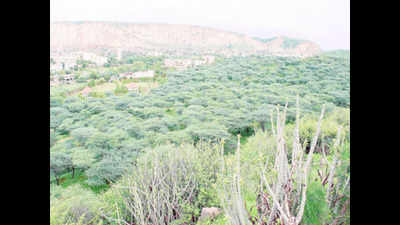- News
- City News
- jaipur News
- Jaipur's Jhalana forest sees rapid growth in leopard count
Trending
This story is from May 17, 2020
Jaipur's Jhalana forest sees rapid growth in leopard count
Jhalana reserve forest, where the country’s first Project Leopard was started two years ago, is becoming a nursery for leopards in the state. This year has seen a rapid growth in leopard population at the city’s Jhalana Leopard Safari Park. The most recent sighting was of leopardess Jalebi with one cub captured on trap camera.

File photo of Jhalana forest
JAIPUR: Jhalana reserve forest, where the country’s first Project Leopard was started two years ago, is becoming a nursery for leopards in the state. This year has seen a rapid growth in leopard population at the city’s Jhalana Leopard Safari Park. The most recent sighting was of leopardess Jalebi with one cub captured on trap camera.
This is the fifth leopardess to give birth in the park since January and now the population stands at 22 adults and 10 cubs, according to the forest official.
“This year, a leopardess called Flaura was sighted with three cubs in the beginning of the year. The other three female leopards LK, Mrs Khan and Sharmili gave birth to cubs subsequently resulting in an increase in the young population,” said a forest official.
After the pictorial evidence, security arrangements have been stepped up in the forest area. The forest department officials are monitoring the movement of the new cub.
Although, the population increase is good news for wildlife lovers, sources at the park involved in its management claimed that Jhalana has more leopards than its capacity. “Jhalana is spread over 22sqkm and the big cat population is higher than its carrying capacity. There are four dominant males (Rambo, Bahadur, Bageehra and Sultan) in Jhalana and two (Bluethunder and Prince) in Galta region. The young leopards do not have any territory and possibilities of straying into residential areas are high,” said an expert.
Currently, there are approximately 35 leopards, including the young offsprings, in the safari park which means less than one square kilometre per animal, once they grow up, claimed experts.
This is the fifth leopardess to give birth in the park since January and now the population stands at 22 adults and 10 cubs, according to the forest official.
“This year, a leopardess called Flaura was sighted with three cubs in the beginning of the year. The other three female leopards LK, Mrs Khan and Sharmili gave birth to cubs subsequently resulting in an increase in the young population,” said a forest official.
After the pictorial evidence, security arrangements have been stepped up in the forest area. The forest department officials are monitoring the movement of the new cub.
A senior forest official further elaborated, “The leopard count has been steadily increasing in this particular forest area, mainly due to efficient monitoring as well as significant efforts to provide a protected environment to the wildlife.”
Although, the population increase is good news for wildlife lovers, sources at the park involved in its management claimed that Jhalana has more leopards than its capacity. “Jhalana is spread over 22sqkm and the big cat population is higher than its carrying capacity. There are four dominant males (Rambo, Bahadur, Bageehra and Sultan) in Jhalana and two (Bluethunder and Prince) in Galta region. The young leopards do not have any territory and possibilities of straying into residential areas are high,” said an expert.
Currently, there are approximately 35 leopards, including the young offsprings, in the safari park which means less than one square kilometre per animal, once they grow up, claimed experts.
End of Article
FOLLOW US ON SOCIAL MEDIA










